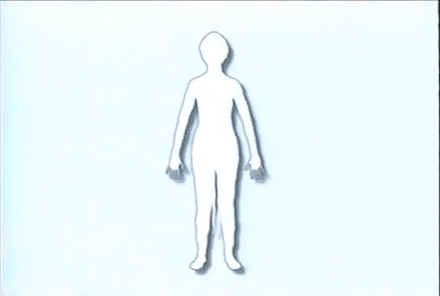#BIOLOGY
Text
EEEEEEEE EEEEEEEEE EEEEEEE
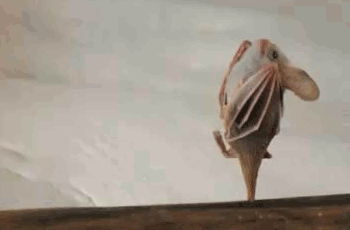
That's right! It's International Bat Appreciation Day! We share our planet with over 1400 species of bat, making the second most abundant mammal order, and they perform a wide variety of ecological roles, from dispersing seeds to pollinating flowers to eating thousands of insects in a single night! Over 200 bat species are listed as Threatened by the International Union for the Conservation of Nature--that is over 14 percent of all bats!
YOU can help endangered bats today by donating to Pennsylvania Bat Rescue at this link. This PA-based organization rehabilitates sick or injured bats and helps educate people like you and me in how we can create more bat-friendly environments.
If you want to learn about particularly-cool bat species native to New Zealand, check out this Consider Nature article on the Pekapeka, the bat that walks:
For the rest of the day, Consider Nature will be bat-bombing Tumblr with some of our favorite bat species to share them with the world!
Alt text: a small brown bat stretching its wings with the kind of fabulous flourish that would impress Ryan Evans.
#animals#nature#science#biology#wildlife#conservation#environment#bats#international bat appreciation day#batbombing
4K notes
·
View notes
Text

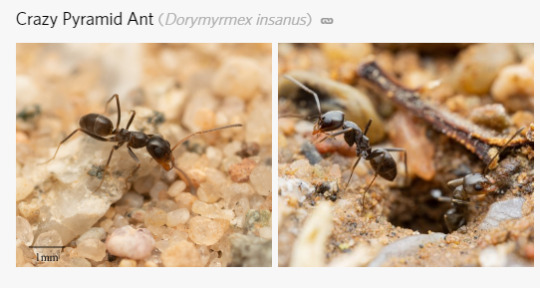
big fan of bug names that sound like they were given by the bug's bitter ex
#insect#insects#bug#bugblr#entomology#bugs#inaturalist#naturalist#nature#ecology#zoology#biology#hawk noises#if anyone has more please add them
257 notes
·
View notes
Text
Wet Beast Wednesday: pistol shrimp
Oh snap, it's the snapping shrimp post for Wet Beast Wednesday! Snapping shrimp or pistol shrimp are loud little critters that have evolves a very useful and fascinating tool in their pincers. Let's not waste time and shoot off to learn about these little gunslingers.
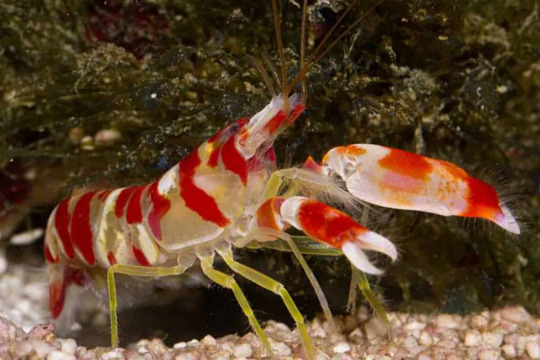
(Image: a pistol shrimp. It is a mostly white shrimp with red stripes. One of its claws is considerably larger than the other. It is standing on gravel and next to some seaweed. End ID)
Pistol shrimp are over 1,000 members of the family Alpheidae, which is part of the infraorder Caridea. This means they are true shrimp, not to be confused with superficially similar animals like brine shrimp, mantis shrimp, tadpole shrimp, and prawns. Yeah, I only recently learned that prawns and shrimp aren't a language difference between British English and American English like chips vs fries. They're not even that closely related. As true shrimp, pistol shrimp have two main body parts: the cephalothorax and abdomen, which are composed of 19 body segments. The abdomen forms a flexible tail with a fin on the end. When startled, the fin can rapidly curl under the body, propelling the shrimp backwards. Like other decapods, there are 10 limbs. The front pair of limbs have evolved into claws used to manipulate objects. The claws are the most distinguishing feature of pistol shrimp. They are asymmetrical, with one growing extremely large, over half the size of the body. The big claw has a modified version of the typical pincer. This pincer has an upper claw that can open up at a right angle. Under the claw is a pocket in the lower pincer, into which water flows. The upper pincer then slams down into this pocket, forcing the water out. The pressure of the pincer closing water in the pocket creates a cavitation bubble that is forced away from the claw at up to 26.8 meters per second. This is enough force to seriously wound small animals and hurt larger ones into leaving the shrimp alone. The cavitation bubbles can reach up to 4,427 degrees C (8,000 F) . For comparison, the surface of the sun is about 1,000 decrees (C) hotter. When the bubble pops, it creates a snapping sound that can reach 218 decibels. For comparison, most gunshots max out at around 170 db. This puts pistol shrimp is the running for the loudest ocean animals, with whales being the other main competitors. If that all sounds like a lot, the whole event happens so fast that the heat doesn't have time to affect much and the noise sounds like a moderately loud snap to us. Adults can snap their claws shut with an acceleration of up to 30 meters per second squared and juveniles can do it up to 20 times faster. The whole process takes less than a millisecond. When the cavitation bubble collapses, it can produce light. This is called sonoluminescence and nobody knows how it happens. If a pistol shrimp loses its large claw, the small claw will grow into a new large one while the missing limb will regenerate into a small claw. Adult pistol shrimp average between 3 and 5 cm long.
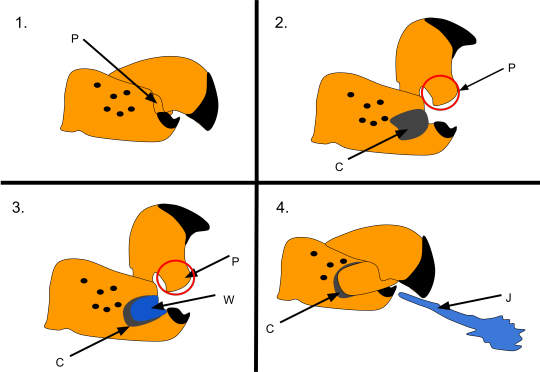
(Image: a drawing showing the process of a pistol shrimp snapping its claw. In the first panel, the claw is closed. In the second, the upper claw opens at a 90 degree angle, revealing a cavity. In the third panel, the cavity fills with water. In the final panel, the claw is closed again and a jet of water is ejected from the claw. End ID. Source: Wikipedia user Carermyers)
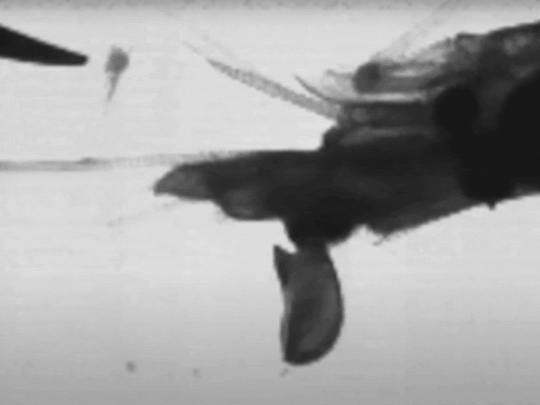
(Gif: black and white, slow-motion video of a pistol shrimp's claw snapping shut and creating a cavitation bubble. End ID. Source)
Pistol shrimp live worldwide, though most species live in tropical or temperate water. There are some cold water species and even freshwater species. Most prefer habitats where they can make burrows and where there are plenty of other animals. Coral reefs, oyster reefs, seagrass beds, mangrove groves are common habitats. Snapping is used for hunting and communication. They typically hide in burrows, waiting for fish or other small animals to pass by. When prey passes, the shrimp will snap to stun or seriously wound the prey, then drag it into the burrow. Some social species actually form eusocial hives with a single queen who produces all offspring. These shrimp are the only known marine eusocial species and all occur within the same genus (Synalpheus), though not every member of that genus is eusocial and eusociality appears to have evolved at least 3 times within that genus. It appears that a reason why only this genus developed eusociality is their larvae do not disperse, instead staying in the same area as the parents. The hives are usually located within sponges. Other social species are not eusocial, but still live together in colonies. Many less social species have formed a symbiotic relationship with gobies. Both species live in burrows, but gobies are bad at digging while the shrimp have poor eyesight. The goby will protect the shrimp while it digs a burrow, then the two live together. They will forage together, with the goby using its superior eyesight to watch for predators and warn the shrimp to get back to the burrow. Pistol shrimp are monogamous, the same pair coming back to mate over and over again (this does not apply to the eusocial species in which only the colony's queen is permitted to mate). The female is only fertile during a short period after molting. The male will stay with the female and protect her during the vulnerable period after mating and some species will remain with each other until the eggs hatch or permanently.
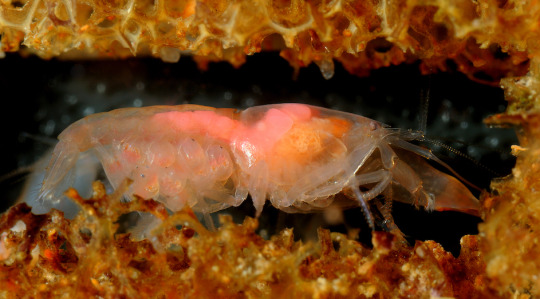
(Image: a eusocial pistol shrimp queen with eggs. Her body is translucent and multiple eggs are attached to her abdomen. The eggs look like translucent balls. The is inside of an orange sponge. End ID)
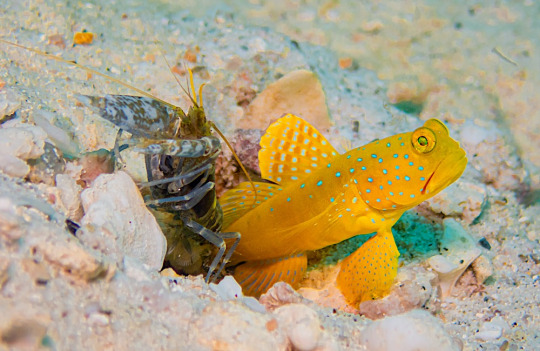
(Image: a pistol shrimp and goby emerging from a burrow in the sand. The shrimp is a mottled green and white. The body is a bright yellow fish covered with blue spots. End ID)
Pistol shrimp are a major source of noise in the places where they live. If you've ever been swimming and can hear repeated cracking noises, that may have been a bunch of pistol shrimp. Some scientists monitor the level of pistol shrimp noises as a method of monitoring the ecosystem. If the noise level drops, that is an indicator that the local ecosystem is suffering. The noise of the shrimps can get so loud that it actually interferes with sonar and forms of underwater communication. During World War II, members of the navy realized that the shrimp disrupted sonar enough to hide submarines, so they started hiding submarines near reefs with lots of the shrimp to keep them from being found by enemy subs. Weirdly not the only small marine animals to mess with submarines. I'll get the the other major one soon. The largest threats to pistol shrimp come from habitat destruction. Some species of pistol shrimp have entered the pet trade. As coral reefs, seagrass beds, and other habitats are destroyed, the shrimp that rely on them will suffer as well.

Yet another time I get to use one of these cards in a post
(Image: the Weird n' Wild Creatures card featuring pistol shrimp. End ID)
#wet beast wednesday#pistol shrimp#snapping shrimp#shrimp#decapod#crustaceans#marine biology#biology#zoology#ecology#animal facts#eusocial#symbiosis#goby#informative#image described
151 notes
·
View notes
Text
Taxonomy Tournament: Birds


Accipitriformes. This order contains most birds of prey: hawks, eagles, vultures, and kites
Corvides. This sub-order is made up of corvids (jays, ravens, crows and magpies), as well as small meat-eating birds of the Old World, such as currawongs and butcherbirds
#animals#biology#polls#poll tournament#zoology#hawks#eagles#birds#tetrapods#jays#ravens#crows#Accipitriformes#Corvides#0x18v0x27
116 notes
·
View notes
Text
Mimicking Plant Movement

Many plants control the curvature of their leaves by selectively pumping water into cells that line the outer surface. This swelling triggers bending. Engineers created their own version of this structure. (Image credit: T. Gao et al.; via GoSM)
Read the full article
115 notes
·
View notes
Text
The lung-cell type that’s most susceptible to infection by SARS-CoV-2, the virus that causes COVID-19, is not the one previously assumed to be most vulnerable. What’s more, the virus enters this susceptible cell via an unexpected route. The medical consequences may be significant.
Stanford Medicine investigators have implicated a type of immune cell known as an interstitial macrophage in the critical transition from a merely bothersome COVID-19 case to a potentially deadly one. Interstitial macrophages are situated deep in the lungs, ordinarily protecting that precious organby, among other things, engorging viruses, bacteria, fungi and dust particles that make their way down our airways. But it’s these very cells, the researchers have shown in a study published online April 10 in the Journal of Experimental Medicine, that of all known types of cells composing lung tissue are most susceptible to infection by SARS-CoV-2.
SARS-CoV-2-infected interstitial macrophages, the scientists have learned, morph into virus producers and squirt out inflammatory and scar-tissue-inducing chemical signals, potentially paving the road to pneumonia and damaging the lungs to the point where the virus, along with those potent secreted substances, can break out of the lungs and wreak havoc throughout the body.
Continue Reading.
64 notes
·
View notes
Text
This school of scalloped hammerheads was not a sight we expected to see, but what a sight it was! Experts are actually unsure why scalloped hammerheads school, but some theorize they school this way as juveniles, and continue the behavior into young adulthood!
#hammerhead shark#scalloped hammerhead#sharks#chondrichthyes#elasmobranchs#marine biology#marine bio#marine biology studyblr#marine bio studyblr#biology#zoology#marine life#animals#scuba diving#marine conservation#ocean
52 notes
·
View notes
Text
Rating the Accuracy of Animal Names:
(I keep updating this list so check back later)
Marine Iguana: 1/10. They don’t allow lizards in the military
Honey Badger: 1/10. It’s not even made out of honey
Horny toad: 0/10. First of all, this is a lizard. Second of all, I couldn’t find one that was willing to have sex with me so they must not actually be all that horny
Crabeater seal: 1/10. They don’t even eat crabs. Felt uncomfortable asking about the other kind but I’d guess probably not those either
Comb jellyfish: 4/10. Doesn’t even have hair
Hammerhead shark: 10/10. Stop killing hammerhead sharks to make hammers
Paper nautilus: 1/10. Paper would get too soggy
Red Panda: 2/10. Not a panda. More orange than red
Jellyfish: 0/10. Not even a fish, but if it were, jelly would be one of the worst things to be made out of
Electric eel: 5/10. Not an eel. Shocking, I know
Blue footed booby: 2/10. My disappointment is immeasurable. Turns out this lying sack of shit is a just a stupid BIRD
Spiny lumpsucker: 8/10. Apparently this fish is named because it has spines AND a suction cup, not because it sucks on spiny lumps
Pleasing fungus beetle: 2/10. Why would fungus be pleased by a beetle eating it? It just worked so hard to grow
Chicken turtle: 1/10. This is just a regular turtle, there are no chickens involved
Red lipped batfish: 8/10. Not a bat. Does have red lips. Also looks incredibly sexy with that makeup on
Aye aye: 10/10. Does in fact, have two eyes
Blobfish: 10/10 out of water, 1/10 in water. The blobfish gets a bad rap, it only looks like a blob because some dickhead pulled it out of its natural habitat at the bottom of the fucking ocean. You’d look pretty weird if you switched places with them too
Dik dik: 5/10 if male, 0/10 if female. This one’s pretty self explanatory
Mountain chicken: 0/10. THIS IS A FUCKING FROG. STOP NAMING ANIMALS AFTER CHICKENS!
Peacock: 0/10. It pees out of a cloaca, not a cock. Technically it doesn’t even pee either
Monarch butterfly 1/10. They aren’t even one of the species of insects that has a queen, let alone understands the concept of monarchism
Cockatiel: 0/10. They do not have teal cocks
Monkey slug caterpillars: 1/10. These are neither slugs nor monkeys, nor are they some kind of fucked up monkey/slug hybrid. Terrible name all around, the only part they got right was caterpillar
Robin: 5/10. It’s a shame this bird has to resort to thievery but we all have to put worms on the table somehow
Alligator snapping turtle: 1/10. This is not an alligator, nor does it even have the fingers to snap with
Ground squirrel: 5/10. Please don’t grind squirrels
Axolotl: 0/10. Doesn’t ask a lot. Doesn’t ask anything at all
Sea robin: 7/10 This is what happens when the land robin goes pro. This creepy fuck evolved little fingers just to steal things. Is this where fish fingers come from?
Tasmanian devil: 8/10. Much like the christian devil, cool name and way more chill than most people give them credit for. Statistically speaking, they’re far from the deadliest player on the board, but they do have the strongest bite force and won’t hesitate to use it if provoked
Water deer: 7/10. No. This is a meat deer
Star nosed mole: 7/10. Name is somewhat misleading, nose merely star shaped, and not a mass of incandescent gas, a gigantic nuclear furnace
Paddlefish: 3/10. Too narrow to effectively be used as a paddle
Shoebill stork: 1/10. Not made of real shoes. Doesn’t pay bills either
Great white shark: 8/10. I’m inclined to agree for the most part but who came up with the name, David Duke?
Bioko drill: 0/10. At least the hammerhead shark looks like a hammer, this stupid monkey doesn’t even remotely resemble a drill
Hippo Tang: 0/10. That’s a fish, and hippos don’t even drink Tang
Bluejay: 3/10. Not actually blue, it’s just a trick of the light. I bet their real name probably isn’t even Jay either
Satanic Nightjar: 4/10. Should be called “slightly evil looking bird” instead
Tarantula hawk wasp: 1/10. Not a tarantula. Not a hawk. Starting to question if it’s even a wasp
Goblin shark: 10/10? Ever seen their jaw move? They sure are gobblin’
Nudibranch: 5/10. The nude part is accurate but it’s a sea slug, not a tree branch. Not even sure how you could possibly make that mistake
Mongoose: 0/10. No mon, it’s not a goose
Bison: 7/10. I just googled it, bison have more gay sex than straight sex so calling them bi is actually pretty accurate. Points removed because there are bidaughters too
Ram: 10/10. They sure do!
Mandrill: 2/10. They could probably be taught to use drills but I couldn’t find any research on this
Silver fox: 1/10. Silver is way too heavy of an element for an animal to be made of
Mayfly: 9/10 Yeah, they might
Fin whale: 10/10. Yep, whales have fins. Glad we cleared that up
Macaroni penguin: 1/10. They don’t eat macaroni
Horseshoe crab: 0/10. Not a crab. Doesn’t wear horseshoes either
Fangtooth: 10/10. Objectively I have to give it a 10 but this is the stupidest fucking name on the whole list. What’s next, knucklefist? Titboob?
Milkfish 1/10. If I go to your house and you offer me fish milk I’m fucking leaving
Little penguin: 10/10. Telling it exactly like it is
Spider monkey: 1/10. Was expecting a monkey with 8 limbs. Let down once again
Glass frog: 2/10. Not actually made out of glass
Hummingbird: 1/10. They can’t even hum
Centipede: 3-35.4/10. Depends on the species, very few actually have 100 legs
Millipede: 0.8-8/10. They have 800 legs at the most
Sockeye salmon: 1/10. Socks would make terrible eyes
Furry lobster: 10/10, 11/10 if that’s a fursuit
Flying fish: 4/10. Merely glides
Sailfish: 3/10. Doesn’t actually know how to sail
Blanket octopus: 2/10. Octopuses make terrible blankets
Cane Toad: 2/10. Can walk just fine without a cane
#biology#evolutionary biology#evolution#science#animals#animal#r/196#196#r/196archive#/r/196#rule#meme#memes#shitpost#shitposting#Darwin#funny#lol#funny shit#funny content#funny memes#funny stuff#sharks
43 notes
·
View notes
Text
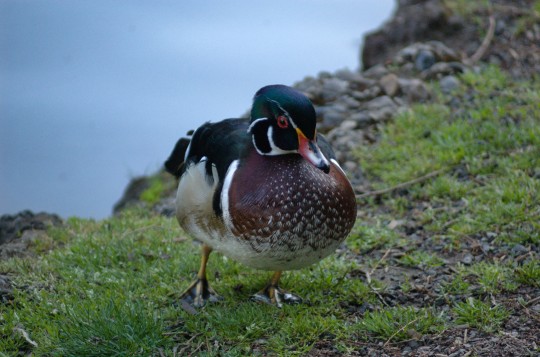

Beautiful boy at the pond
36 notes
·
View notes
Text


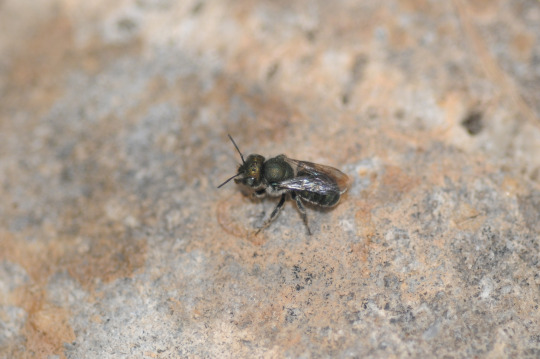
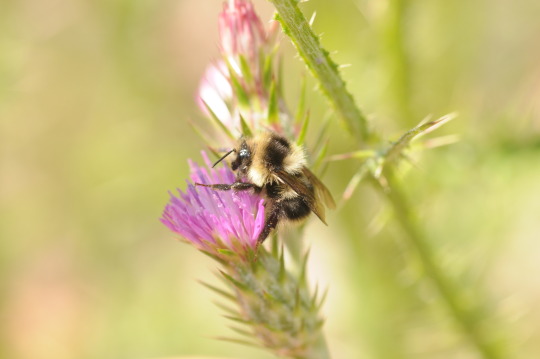
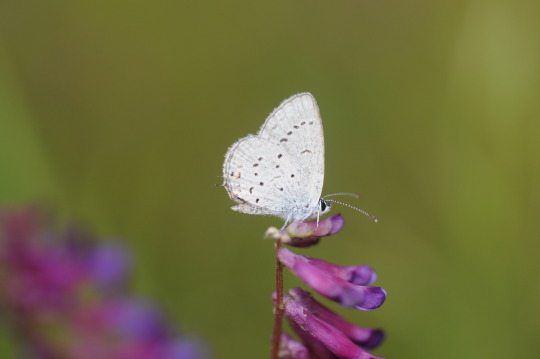
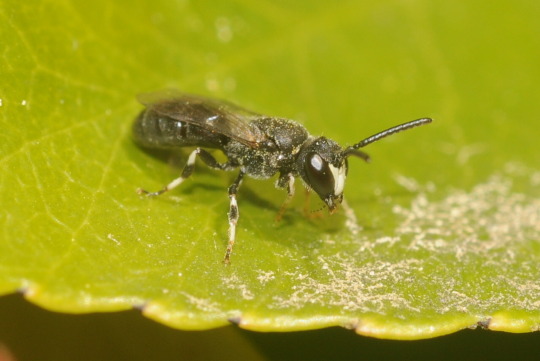
Genus Gasteruption, Genus Ischnura
Genus Osmia, Black-tailed Bumble Bee (Bombus melanopygus)
Western Tailed-Blue (Cupido amyntula), Genus Hylaeus
my camera has been acting up(nearing the end of its life, probably), so it's been a struggle to get decent shots. i managed to scrape together a handful i'm pretty happy with, though
#inaturalist#naturalist#nature#ecology#zoology#biology#insect#insects#bug#bugblr#entomology#bugs#photography#nature photography#wildlife photography#hawks photos#butterflies#lepidoptera#insectblr#bees#wasps#hymenoptera#damselflies#bummed abt the camera but what can you do. its 20 years old#working on getting a replacement but im using this one until it literally wont let me anymore#so dealing with it despite the annoyance it is!
22 notes
·
View notes
Text
Taxonomy Tournament: Cephalopod Finale!
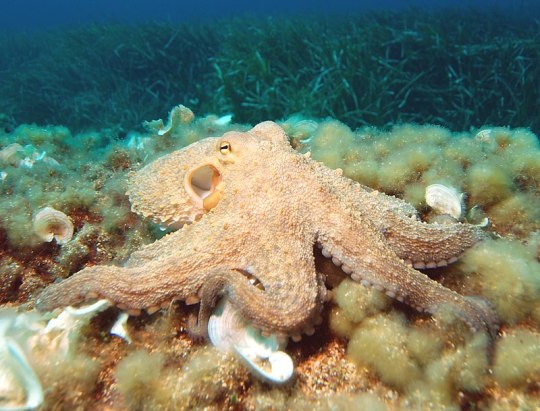
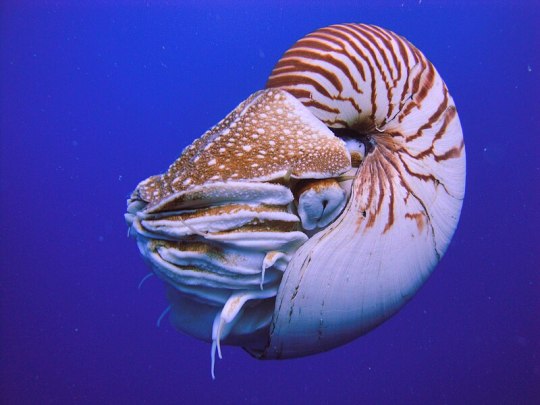
Octopoda. This order is made up of octopuses, predatory marine creatures with eight limbs. Their soft body allows them to squeeze trhough small spaces. They are capable of camouflage and are among the most intelligent animals.
Nautilida. This order is made up of nautilis, which have a unique planispiral shell, and move via jet propulsion. They're morphologically veyr similar to their ancient relatives, and are often called living fossils.
#animals#biology#polls#poll tournament#zoology#octopus#octopi#octopuses#molluscs#cephalopods#spiralia#nautilis#Octopoda#Nautilida#0x15v0x2a
105 notes
·
View notes
Text



an entire year reduced to three pages
insane
#studyblr#study motivation#study#study aesthetic#study blog#studyspo#study-core-101#student#study community#studyinspo#study notes#studying#studying inspo#studying inspiration#studying notes#notes#biology#student life#students#tests#exams
34 notes
·
View notes
Text




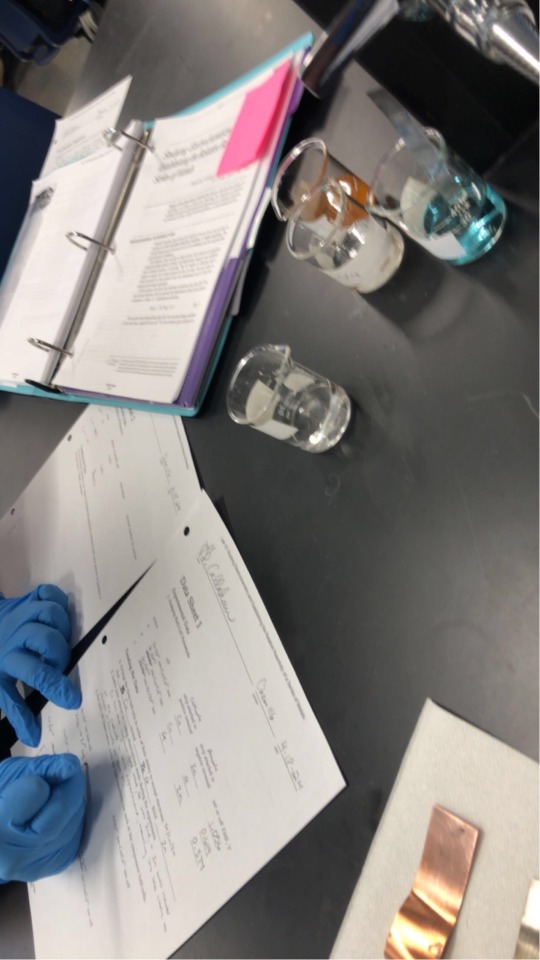




Photo dump! My roommate and I tried out a new cafe in town, finals are coming up, final chem lab for the year had been done, etc. Man I am tired
#college#student#chemistry#studyblr#biology#biochemistry#study aesthetic#study desk#study motivation#romanticizing school#romanticizing stem#romanticizing science#romanticizing college#stem academia#stem#stem aesthetic#stem studyblr#stemblr#stem student#study blog#studyspo#studying#finals#romanticizing finals
20 notes
·
View notes
Text
Quick drawings showing AU Sonic and Shadow’s nervous system differences, and consequent strengths/weaknesses. Sonic has keen sensory perception but is vulnerable to pain. Shadow is impervious to pain but has dull senses.


21 notes
·
View notes
